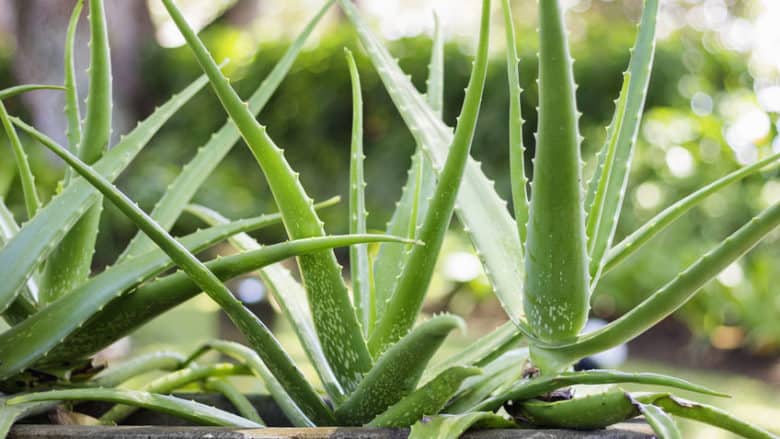
Aloe benefits: My mom always had an aloe plant in the kitchen. Aside from enjoying its cactus-like beauty, she would snip a leaf to apply its clear gel to my burns and scrapes.
To this day, the plant inspire images of healing as it always soothed my hurts.
Now, you can find big jugs of aloe vera juice at health food stores; people rub it on their skin and drink it as a cure all or to treat specific conditions. This sparked my interest to know more about aloe benefits.
What Is Aloe?
Aloe is the name of a plant genus which has over 400 species. One of these species, Aloe vera is most commonly used in health and other consumer products. Aloe vera’s botanical name, Aloe barbadensis miller may also be used on product labels.
The aloe plant forms a rosette of large green, spiked shaped succulent leaves. In some species the leaves emerge from the ground, in others they emerge from a stem.
Aloe leaves consist of 99 percent water and 75 potentially active constituents like vitamins and substances known as glycoproteins and polysaccharides.
Glycoproteins speed the healing process by stopping pain and inflammation, while polysaccharides stimulate skin growth and repair. They may also stimulate the immune system, report University of Maryland Medical Center experts.
Another substance found between the rind and the inner leaf material, aloe latex, contains anthraquinones, including a powerful constituent called aloin which acts as a laxative, reports International Aloe Science Council (IASC) experts.
Aloe Benefits History
Aloe vera enjoys a rich history as a natural healing herb. It was known as “the plant of immortality” in early Egypt, and depicted in an ancient cave painting in South Africa as a medicinal.
Known for its natural healing qualities, it was one of the most frequently prescribed medicines during the 18th and 19th centuries and remains one of the most commonly used herbs today, say University of Maryland Medical Center Experts.
Aloe Benefits
Aloe’s clear gel is used in beauty products and on the skin as a topical ointment to treat minor burns, wounds, and various skin conditions:
- Psoriasis
- Seborrhea
- Genital Herpes
- Lichen Planus
When taken by mouth it is used as a natural food flavoring and to treat a variety of conditions:
- Diabetes
- Asthma
- Epilepsy
- Osteoarthritis
- Ulcerative Colitis
- Constipation
See what the research says about these benefit in this article: What Do Aloe Vera Studies Say?
Safety and Precautions
Using aloe vera on your skin is safe and is not associated with any side effects. However, allergy to aloe has been noted. If you develop a rash, stop using it.
Studies do not support its use for deep or open wounds, or for significant burns including those caused by radiation.
Taking aloe by mouth has the following precautions:
- Aloe latex orally may cause painful abdominal cramps or diarrhea and is not recommended.
- Non-decolorized whole leaf extract of aloe vera showed clear evidence of cancer causing activity in rats, according to a 2-year National Toxicology Program (NTP) study.Aloe vera gel or decolorized whole leaf aloe vera extracts were not included in the study.
“The difference between decolorized and non-decolorized whole leaf extracts is mostly in how the leaf is processed or filtered. In many cases, manufacturers of oral products containing Aloe vera use a charcoal filtration process to decolorize and remove some of the components from the leaf, including anthraquinones. Anthraquinones act like laxatives. Some anthraquinones have previously been shown to be carcinogenic,” report study authors. More information is needed to determine the potential risks to humans, say NTP experts. - Aloe may lower blood glucose levels so those with diabetes who use glucose-lowering medication should be cautious in taking it.
- Aloe latex may decrease potassium levels in the body. It should not be used by those taking potassium lowering drugs like diuretics or digoxin as the combination may cause potassium levels to fall too low, say University of Maryland Medical Center experts.
- Pregnant women should not take aloe latex because of the risk of abdominal cramping precipitating labor.
- Nursing mothers should not take it as the effects and safety for infants and children are not known.
Dosages
Studies, typically use topical aloe vera cream (0.5% aloe) applied three times daily and 1 tablespoon of aloe juice two times a day for diabetes treatment, reports ConsumerLab.com experts.
Look for International Aloe Science Council (IASC) certification when buying aloe products. The IASC developed a certification for aloe products due to abuse in manufacturers representing the true amount of aloe on their labels.
It is best to check for products that have achieved certification on their website, as some manufacturers fake certification on product labels.
Aloe Benefits Key Points
Aloe vera helps heal minor burns and abrasions, and may help with serious conditions like diabetes and ulcerative colitis.
Aloe benefits have earned its reputation as a top natural healing herb, however be informed on its precautions before using it by mouth.
Sources and Resources
ConsumerLab.com, Natural and Alternative Treatments, “aloe,” http://www.consumerlab.com/tnp.asp?chunkiid=21470&docid;=/tnp/pg000227.
National Center for Complementary and Alternative Medicine, herbs at a glance, “Aloe Vera,” http://nccam.nih.gov/health/aloevera.
The International Aloe Science Council at http://www.iasc.org/index.html.
University of Maryland Medical Center, “Aloe,” http://www.umm.edu/altmed/articles/aloe-000221.htm.
